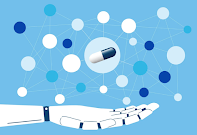The AI Revolution in Drug Discovery: Transforming Healthcare
By: Aidan McCartin
In recent decades, Artificial intelligence has permeated virtually every aspect of our lives, and its influence is only set to expand further. According to GlobalData, the AI market will be worth $909 billion by 2030, demonstrating the technology’s widespread use and growing potential. One area where AI is making significant strides is drug discovery and development, offering the promise of revolutionizing patient experiences and outcomes. The use of artificial intelligence in this field has the potential to shorten the time and lower the cost of bringing new pharmaceuticals to market, with a particular emphasis on solving unmet medical needs such as uncommon diseases and novel antibiotics.
Recently, advances in computational technology have reshaped the field of drug discovery. Adoption of in silico approaches, in which research is carried out using computer simulations, has resulted in improved traditional drug development practices. These computational technologies have the potential to speed up drug development while reducing costs and timelines. Despite these advancements, the drug development process remains loaded with problems. Only 10% of prospective drug candidates progress from preclinical to clinical trials. The low success rates and resulting financial burden have fueled a search for alternate ways, resulting in the introduction of AI in drug discovery.
AI has enormous potential for enhancing in silico methods by rapidly processing and exploring the vast chemical space, made possible by the exponential growth of biomedical data. Researchers have gained a better grasp of the core mechanisms underlying diseases due to AI models trained on massive amounts of genomic data, health records, medical imaging, and patient information. By mapping illness pathways and detecting protein-drug interactions, AI has led to the discovery of new proteins and genes that can be targeted to treat diseases. Furthermore, AI can predict the three-dimensional structures of pharmaceutical drugs using databases such as DeepMind’s AlphaFold, speeding up the design of appropriate treatments and medications.
AI does not end at drug recognition. It is also important in candidate drug prioritization, ranking compounds for future evaluation. Furthermore, AI algorithms have shown the ability to reduce the traditional four-to-five-year exploratory research phase to less than a year. This time and cost savings are especially significant for medical conditions with restricted treatment alternatives, such as rare diseases.
In recent years, there has been a rise of interest in the use of AI in drug discovery, resulting in the formation of multiple firms, partnerships, and record levels of investment in this industry. Significant milestones have occurred in 2023, revealing AI’s transformational potential. In January, for example, AbSci made a breakthrough by utilizing generative AI to develop and validate de novo antibodies in silico. This innovative approach has the potential to drastically shorten the time it takes to transfer new medication leads into clinical trials. Similarly, Insilico Medicine was granted orphan drug designation by the FDA in February 2023 for a small molecule inhibitor treatment designed through their generative AI platform, Pharma.AI.
Even though there is significant progress in the application of AI in drug discovery, the majority of AI-developed medications are still in the preclinical or discovery stages. It could more than likely be years before an AI-based medicine receives regulatory approval. Concerns about data quality, medicine safety, effectiveness, community education, and intellectual property rights are among the many obstacles to widespread adoption. Nonetheless, AI’s early impact on traditional drug discovery techniques can be seen. AI has the ability to speed and reduce the costs of conducting expensive tests when integrated into traditional methods, providing massive benefits for patients, medical practitioners, and the pharmaceutical industry.
Despite these advancements, it is important to remember that fully realizing AI’s potential in drug discovery is a difficult process. These include issues with data quality and ethics, regulatory approval challenges and the need for more scientific education and collaboration. As these challenges are overcome, we may expect that AI will play a pivotal role in expediting drug discovery, reducing costs, and ultimately improving patient outcomes.
To summarize, AI’s breakthrough into drug research is a stunning demonstration to technology’s possibilities in altering healthcare. We can look forward to a future where AI-driven innovations help address some of the most pressing medical challenges and bring hope to patients, like my uncle, with unmet medical needs, thanks to ongoing research and development, regulatory changes, and increased acceptance of AI in the scientific and medical communities.
Work Cited
Healthcare, GlobalData. “Ai Essential for Drug Development and Discovery.” Pharmaceutical Technology, 10 Aug. 2023.
Paul, Debleena, et al. “Artificial Intelligence in Drug Discovery and Development.” Drug Discovery Today, U.S. National Library of Medicine, Jan. 2021.


Comments
Post a Comment